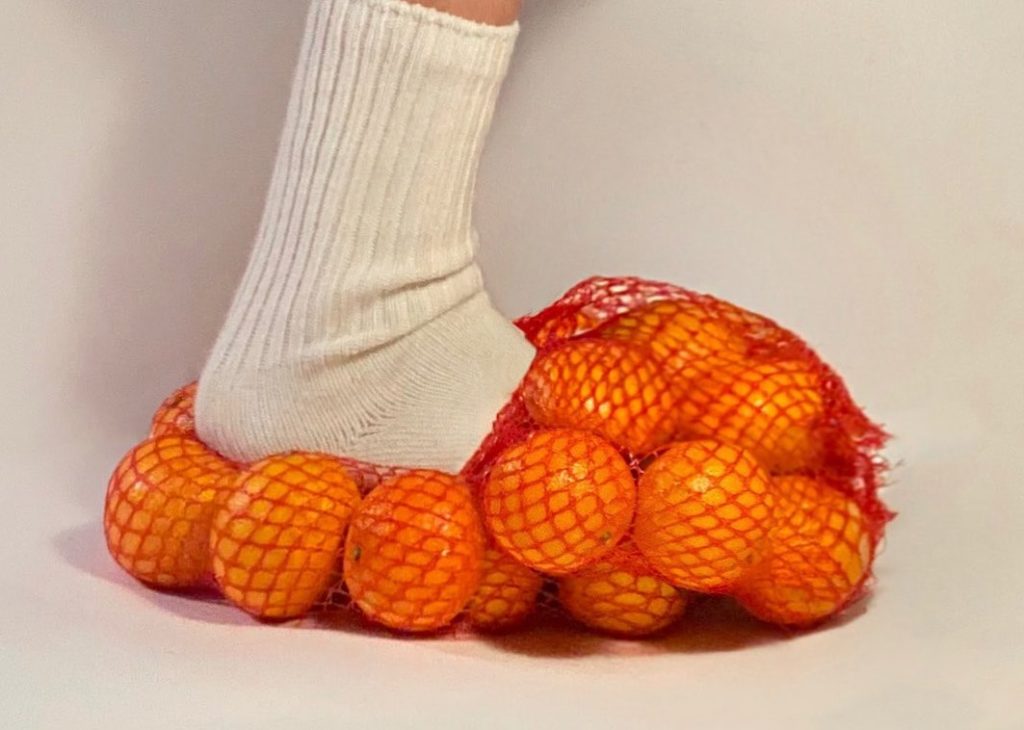Designer Nicole McLaughlin has built an Instagram following of close to half a million followers delighted by her conceptual footwear and clothing designs making use of unanticipated materials.
A designer at Reebok when began posting her designers on Instagram, she’s now working for herself and recently landed her first official footwear collaboration with Crocs.
While her designs are no doubt populating mood boards behind the scenes everywhere, at least one company appears to have gone from inspiration to actual product. Working off of a shoe she posted in December 2019 whose upper is constructed from a mesh bag full of oranges, the take down version features a similar silhouette but constructed with rubber. Touching on the mesh bag, the orange-shaped balls are imprinted with a square grid.
It seems there are several companies offering the shoe, making it likely that one factory is manufacturing the shoe and selling it to any number of online stores. We spotted a company called Juice Memory selling the shoe on Facebook with ads on Instagram which were filled with complaints about its resemblance to McLaughlin’s designs.
The company describes itself as selling “the coolest viral gadgets, gizmos, and household items that you would need but probably haven’t heard of yet, all in one place.”
This appears to be a blatant case of ripping an idea from McLaughlin’s feed and turning it into a product. While design concepts are not only difficult but expensive to protect through copyright, it doesn’t make it okay that brands are using images they discover on Instagram as sources for preliminary CADs.
We reached out to McLaughlin to get her thoughts on brands pulling inspiration from her unique one-off items. In her response, she highlights how creativity is used against a person by brand’s who may lack ideas but are well funded when it comes to access to cheap materials, manufacturing and an established distribution system. Rather than pay for a consultation, they simply rip the idea from Instagram.
Notably, she points out that her designs are only one-off items due to time constraints and financial reasons. Check out her response below. Check out her response below.
Risk is a huge factor when posting your work online, and that applies to anyone. But sharing should not be confused as permission to then use it without paying for it. Social media is crucial in getting your ideas out there, and the worst feeling is when it’s stolen with absolutely no credit or compensation.
You could argue that I’m at fault because I put it out there. However, you forget the bigger picture. Often in these cases, we’re dealing with companies that have the resources to move quickly on an idea to monetize them. I’m an independent designer who makes everything by hand, and decisions have to be weighed financially on what I can invest in to make a living. If money weren’t an issue, I’d make it all.
Yes, I posted a concept piece online. Yes, it’s not technically functional. But just because my work ends up on a mood board does not mean anyone should be allowed to make it the whole mood.
No creator should feel like they can’t share their work for fear of being plagiarized. If I had never shared mine, I wouldn’t be in the position I am today. It’s a risk, but ultimately you hope there are companies out there looking to do the right thing.
For the most part, the explosion of online platforms has been a gift for creatives who have been able to bypass industry gatekeepers and build followings as powerful as their visions. Social media has also enabled small designers in some cases to push back on ideas stolen by bigger brands through follower-generated campaigns that are picked up by major media outlets.
However, even as bigger brands and retailers are taking a more considered approach to blatantly stealing from ideas found on social media feeds, the thievery continues unabated.
The solution remains simple. Pay creatives for their ideas whether as consultants or collaborators. While companies may save some money upfront when they choose to steal ideas rather than compensate the creative, the cost of damage to reputation for companies that loot from designers is very high if not irreparable when the theft is exposed especially among younger consumers who have a laser focus on ethical behavior.
If a company has a big enough infrastructure to mass produce product, it has the budget to pay everyone involved in its creation. Any other approach is an unarguably dishonest business practice.






